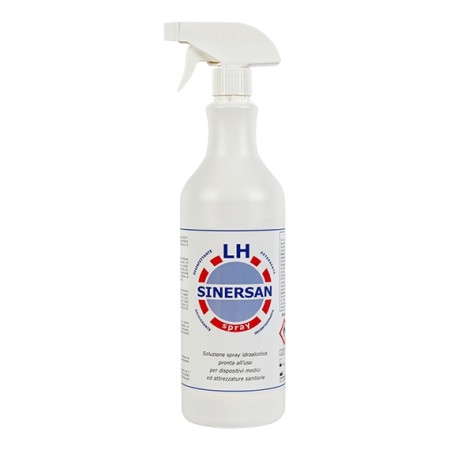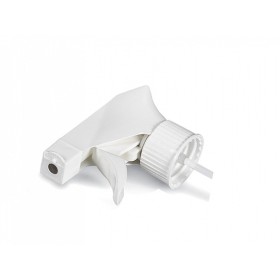by credit card, Paypal and bank transfer.
with BRT, DPD and FedEx couriers
via Whatsapp + 39.371.43.61.201
The sprayer is supplied 1pc per 2 bottles.
LH Sinersan Spray is a ready-to-use hydroalcoholic solution, disinfectant and detergent with a broad spectrum of action, consisting of a synergistic combination of different biocidal agents. For the rapid and effective disinfection of medical devices, hospital and outpatient equipment (instrument shelves, lamps, trolleys, basins, furniture, wheelchairs, beds, dental unit chairs, etc.).
CE 0051 MEDICAL DEVICE: CLASS IIb
Ingredients:
100 g of solution contains:
- Benzalkonium chloride 0.10 %
- Didecyldimethylammonium chloride 0.07 %
- Chlorhexidine digluconate 0.05 %
- Ethyl alcohol 52.0* %
- Co-formulants and purified water q.b. to 100 %
* Equivalent to 52% w/w and 58% v/v of ethyl alcohol.
Product features:
Ready-to-use hydroalcoholic solution, disinfectant and detergent, with bactericidal, virucidal and fungicidal action consisting of a synergistic association of different biocidal agents.
- Appearance: Clear, colorless liquid
- Smell: Citrus
- pH: 6.20 ± 0.50
Areas of application:
Quick and effective disinfection, deodorization and cleaning of medical devices, hospital and outpatient equipment (instrument shelves, lamps, trolleys, basins, furniture, wheelchairs, beds, dental unit chairs, etc.).
Disinfection and decontamination of contaminated instruments prior to sterilization; to prevent the spread of microorganisms during the collection of infected materials.
How to use:
It is used pure, without dilution, nebulizing it in order to completely cover the surfaces and objects to be treated.
The solution evaporates quickly. There is no need to rinse, but dry any residue with dry and clean paper or cloth.
Leave on contact for at least 3 minutes.
Mechanism of action:
At relatively low concentrations, the action of chlorhexidine is bacteriostatic, while at higher concentrations the action is rapidly bactericidal. The lethal process has been shown to consist of a series of related physiological and cytological changes that culminate in cell death, in particular the hypothesized sequence is as follows:
- Rapid attraction to the bacterial cell
- Specific and strong adsorption to certain compounds containing phosphate groups on the bacterial surface
- Resistance to bacterial cell wall exclusion mechanism
- Attraction to the cytoplasmic membrane
- Release of low molecular weight cytoplasmic components (e.g. potassium ions) and inhibition of certain membrane-bound enzymes such as adenosine triphosphatase
- Precipitation of the cytoplasm by the formation of complex salts with phosphated entities such as adenosine triphosphate and nucleic acids
Quaternary ammonium compounds have a similarity in mechanism of action with chlorhexidine but differ substantially in their interaction with the cell envelope.
The outermost surface of bacterial cells generally has a negative charge, often stabilized by divalent cations such as Mg2+ and Ca2+. Often, cationic antimicrobials require only a strong positive charge together with a hydrophobic region in order to interact with the cell surface and integrate with the cytoplasmic membrane. Such integration within the membrane is sufficient to disrupt its growth and at the treatment levels associated with disinfectant and antiseptic formulations it is sufficient to cause loss of fluidity with consequent cell death. The mode of action of quaternary ammonium compounds against bacterial cells is found to involve a general perturbation of the lipid bilayer that constitutes the bacterial cytoplasmic membrane and the outermost membrane of gram negative bacteria. This action leads to a generalized and progressive release of cytoplasmic material towards the external environment. The virucidal action takes place on the protein and/or lipid coat of the virus, which contains and protects the genetic material, inactivating it.
Finally, ethyl alcohol, due to the multiple mechanisms of toxic effect, can be considered a non-specific antimicrobial. The main mode of microbicidal action of alcohol is related to its coagulating/denaturating action on proteins. Alcohol-induced protein coagulation involves the cell membrane, cytoplasmic membrane, and various plasma proteins. The coagulation of enzymatic proteins leads to a loss of cellular functions. Alcohols target the bacterial cell membrane with the resulting lysis and release of cellular contents.
Specifications:
!! ATTENTION!!
The sprayer is supplied 1pc per 2 bottles.
Equipment:
1 bottle of 1000 ml











